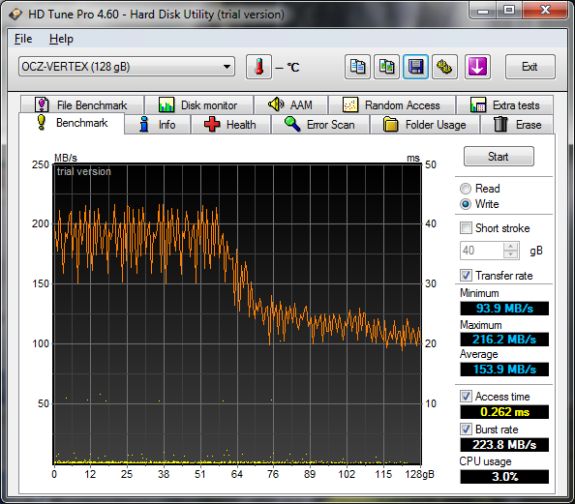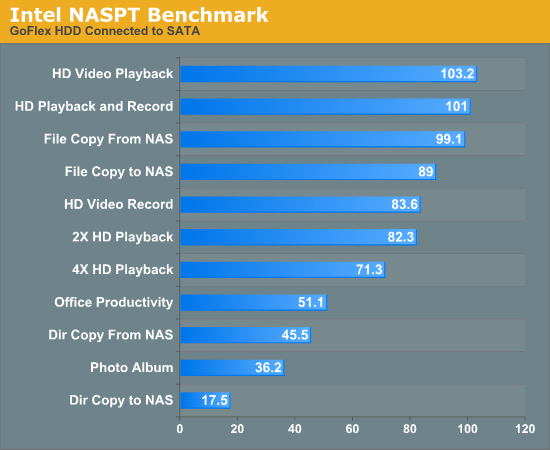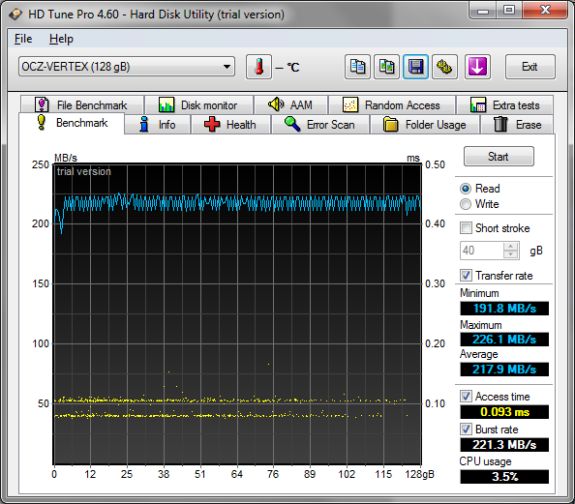Seagate GoFlex Home 2TB Reviewed
by Rajinder Gill on October 10, 2010 5:05 PM EST|
Testbed Setup Overclocking / Benchmark Testbed |
|
| Processor | Intel i5-750 CPU - 2.66GHz, 8MB L3 Cache |
| Motherboard | Biostar TPOWER I55 |
| OS Hard Drive | WD 250GB Caviar Black |
| Benchmark Drive | OCZ Vertex 120GB |
| Memory |
CorsairXMS3 CMX8GX3M4A1333C9 DDR3-1333 CAS 9-9-9-24 2GB |
| Video Cards | MSI 275 Lightning (stock clocks) |
| Optical Drives | Plextor PX-B900A, Toshiba SD-H802A |
| Case | LIan Li V-2110 |
| Operating System | Windows 7 64 bit |
| . | |
Our test system consists of Biostar’s TPOWER I55 motherboard, teamed up with an Intel i5-750 Lynnfield processor. We utilized Intel’s NASPTexerciser to benchmark the Go-Flex Home. Windows 7 Ultimate provided the foundation for our test, although we used 2GB of memory as per Intel recommendations to ensure benchmark accuracy (preventing caching of data). A 250GB WD Caviar Black HDD is used for our OS installation, while the NASPT benchmark is run from the OCZ Vertex SSD. We include screenshots of the Vertex's read and write performance below:

OCZ Vertex 120GB Read and Write Performance.
Our test system should have more than enough bandwidth to highlight potential bottlenecks at the GoFlex end of the line. The network drive is attached directly to the test client machine via the onboard Intel 82578 NIC.
NASPT Benchmark
The NASPT exerciser generates traffic at the file system level using typical user application semantics. The traffic generated emulates actual traces of real applications’ file system requests. We ran the entire benchmark test three times, closing the test suite between runs and opening other software - again, this was done to ensure caching did not skew results.

The read based tests seem to fare pretty well, anything involving write operations though, seems to end up sub-par. To confirm a controller/drive level problem we removed the GoFlex from its docking station and attached the drive directly to a SATA port on the test client machine:

File copy times over the SATA bus see a huge boost over the ethernet~docking station combo. The write bottleneck appears to be a facet of the controller -why the problem exists we're not sure, it obvously means that large file transfers over a network could end up taking painfully long on the GoFlex.
Temperatures
Unfortunately, Seagtate’s bundled software does not include provision for temperature monitoring. Third party SMART monitoring software won’t pick up the drive’s vital statistics via Ethernet ports either. The only way we could get an indication of temperatures was to remove the drive section and plug it into a motherboard via SATA instead. This proved to be a bit of a challenge as the SATA connector is recessed to the extent where we needed to shave the end connector on the cable down for it to fit through the slot in the casing. Here's what we ended up with after a couple of hours of continuous use in an ambient room temperature of 17 Celsius:
| GoFlex 2TB Temperature | |||||
| Idle | Load | ||||
| 34C | 43C | ||||
The end result here is nowhere near as bad as what Anand got from the 3TB unit, although we should be mindful of the fact that we’ve taken the base unit out of the equation here. At a guess the base unit will add another 5~10 Celsius to the temps, bringing us into the fifty Celsius region during sustained use - it's acceptable.
Power Consumption
| GoFlex 2TB Power Consumption | |||||
| Idle | Load | ||||
| 4W | 10W | ||||
We measured power AC consumption of the GoFlex unit at the mains. The GoFlex goes into Idle mode after abour 30 minutes of inactivity, at which point the power consumption will drop to around 4W. A "full load" power draw of 10W is fine for a network drive of this size.
Final Words
If you're looking for a plug-and-play NAS drive, the 2TB GoFlex certainly has its appeal. Unlike the 3TB USB drive that Anand reviewed last month though, Seagate aren’t the only players in the segment as there are other 2TB network drive options out there at a similar price ($200~$230). Most of the paper specs are largely similar, leaving things down to certain aspects of performance, bundled software, user interface flexibility and upgradeability.
The GoFlex Home manages to tick most of the software and ease of use boxes, and even has a window of opportunity for drive replacements and "upgrades" (if one outgrows 2TB of storage). The caveat with the replacements/upgradability being that you're tied to using a GoFlex unit due to the propietary mating mechanism of the drive and base unit. That being said, standalone single drive units like these from other vendors aren't known for offering such options at all, so Seagate manage to do enough to obtain a small lead even though it's not perfect.
This time round, we're pleased that we don't have to issue a word of caution about operating temperatures like we did on the 3TB GoFlex Desk. The 2TB GoFlex Home seems to operate within the bounds of what we'd deem safe without impacting drive longevity.
Our only major gripe with the GoFlex Home pertain to the rather slow write performance; it's a fraction of the read speed. If you're buying 2TB of network storage you're likely to have a serious amount of data to shift over to the drive at some point - it's not a pleasant experience on the GoFlex. We also think that the 2TB version of the drive should offer the ability to create an unlimited number of user accounts as standard rather than asking users to fork out a $19.99 per annum subscription for the privelage.
Unfortuantely, we have yet to test similar sized NAS drives from other vendors so can't say for certain if or how far the GoFlex's write performance lags behind the competition - we're trying to get more samples in so that we can make a more informed conclusion. For now, we'll finish off by saying that if you can put up with the slow write performance (or if time is not of the essence), the GoFlex Home has plenty going for it as an easy-to-use network drive that will get the job done.











30 Comments
View All Comments
Rajinder Gill - Tuesday, October 12, 2010 - link
Thanks, plenty to take on and consider there - it's all appreciated!!-Raja
kmmatney - Tuesday, October 12, 2010 - link
Thanks - I think this unit isn't bad for purposes of backing up data - since you are getting redundnacy by the fact that you are using it for backups of other hard drives. It really needs redundnacy to be used as a central location for data.Dobs - Tuesday, October 12, 2010 - link
Just wondering how DLNA works on this thing....After much trial and error using DLNA software (including Sony recommended) I found Mezzmo to be the only software that really works with my Sony KDL40HX700 TV (running from my PC) and it works great...
... But how does DLNA work on this thing? Is it Pictures and Music only? What file types? What resolutions can be played? Can I fast forward/rewind with TV remote? etc... Will it work on my Sony TV?
I'd really appreciate reviews of products that supposedly have DLNA functionality to actually be tested to see how extensive that functionality is.
Duftopia - Sunday, September 14, 2014 - link
Be prepared to download most of your movies, the software streaming features is definitely sub-standard if functional at all.Dug - Tuesday, October 12, 2010 - link
I would really like to see more of these reviews.I think storage is becoming a huge problem for people with multiple laptops, pc's, mac's, etc.
Yes, you can always add external hd's or replace what you have in your computer, but for a lot of us, that is not an effective strategy.
I would really love to see a cheap cheap diy Windows home server too as a comparison. Mainly because of all the features it has compared to some of these expensive NAS solutions.
bluetiki - Tuesday, October 12, 2010 - link
would you also compare against a similar software solutions that offer this functionality (such as Openfiler or FreeNAS? it would be interesting to see how they would stack up, but I guess establishing some kind of baseline for performance would be hard because it would vary so much based on what kind of hardware it was running on.awaken688 - Tuesday, October 12, 2010 - link
Solid article. For many of us readers, we have multiple computers and having centralized storage is something of interest. Some future items I'd love to see reviewed. It would be perfect for a multi-part article with each part being a review on each item, then the last part being a large overall comparison.Super cheap DIY NAS/HomeServer
HP MediaServer
Higher level NAS systems with RAID 1/5
Drobo
All in 1 Solutions like this
Things to definitely cover:
1) Price
2) Noise and Power (definitely looking for a quiet and power sipping device if possible.
3) Read/Write Speed in a variety of systems
4) Setup Ease
5) Ease of use overall with various OSes.
Good stuff and can't wait to read more.
CrapONez - Wednesday, October 13, 2010 - link
I have an internal 500GB OS drive backed up to an external 1TB drive (only a couple week's worth of backups), an internal 500GB drive filled with a tiny subset of video from my camcorder tapes, backed up to a 750GB external drive, a brand new external 1TB drive that's 80% full connected to my Viewsonic VMP75, and that's not even getting into backing up my kids' computers and my wife's laptop. The article seems to imply 2TB is a WHOPPING amount of storage that no one could exceed. Wrong.I've tried RAID5 on my desktop and lost everything when a disk failed and the array just bit the dust. I've had the same experiences at work - maybe pulling a drive in a test environment proves out RAID5 but oftentimes the array goes with the drive. I feel hesitant to pay extra for features that work only on paper. And as has been said, it's just a matter of time before a drive fails. I've lost 4 in the past 5 years.
But I would love to have central redundant storage for all my needs. The only caveat is it would need to connect to my Gigabit network and simultaneously via eSata or USB to my VMP75. DLNA works for pictures and music, but any kind of MKV or HD streaming needs direct connection to the storage source because , DLNA does not yet deliver (in my mind).
Watwatwat - Thursday, October 14, 2010 - link
meh, considering the constantly failing drives of their other lines like free agent that are cooked to death i wouldn't take the high temps so lightly. being that a nas is always on this is a serious issue. i've had freeagent drives fail several times already, the cases bake the drives without much if any ventilation, it doesn't seem that seagate have changed their ways at all.Duftopia - Sunday, September 14, 2014 - link
Never Externalize a Seagate barracuda, the 7200 rpm on a hot day is not a good idea. THIS drive however runs in the arena of 5200-5400 rpm, its run for 4+ years w/o issues and VERTICALLY as well. You want to keep your drives forever as I have Seagate running 10+ years with no issues but all have the same common factors:1) Make sure the spin horizontally in an upright (not upside down position)
2) Make your "WORK" partition lie at the center of the drive, 3 partitions can do this.
3) The newer 3+ TB drives have construct issues, bruise them up early as work drives,
if they survive the 6 month - 1.5 year mark - then they will make good long term drives.
4) Gauge when they have errors reading / writing when the heat is up, and insure to avoid
running them long under the same conditions in the future, or if the drive is only 2 years old
use the warranty to return them based on this (they typically turn off when they can't take
the heat)
5) Buy non-Chinese and Thailand made units for the 10 year duration, those seagates last 5
year min when the Japanese and tiawan build units go for at least 10, you can tell when 3
year warranty drops to 1 year that's Seagate saying this drive is made cheaper.
6) My old drives going over 10 years were dues to Seagates excellent Customer service, that's
history now, so warranty is the best you are guaranteed.
* Many of these rules did not apply to Seagate for a long time but rather other companies but now the rules have changed and the peasants need to become sharper as the products are deteriorating rapidly, Seagate as of mid 2014 still hold the best grades but I see the writing on the wall.
Duf